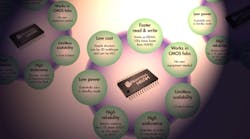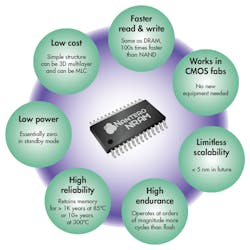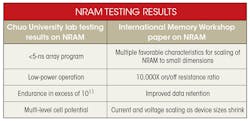This file type includes high-resolution graphics and schematics when applicable.
Memory chips have traditionally been treated as a commodity, with well-defined places for each kind of chip (e.g., flash, DRAM) in systems and device architectures and cost being the top consideration for buyers. Every year or two, a jump in capacity and a reduction in cost per bit was expected and regularly delivered. All of this is starting to change now. Traditional memory is nearing its end of life, and new technologies have emerged to transition memory from a standard commodity check-off to a powerful competitive advantage.
End of an Era
It’s no secret that both flash and DRAM are proving increasingly difficult to scale, with more and more tradeoffs being made with each shrink to a new node. The gap in latency between flash and the CPU is enormous, and has little prospect of changing appreciably. And NAND flash scaling has come at a price in endurance and reliability that puts a greater burden on the customers to develop smarter systems to manage the memory.
Fortunately, emerging new memories offer not only a path to continued scaling, but also open the door to new possibilities for how and where memory is used. This means that memory can now be a significant source of competitive advantage for manufacturers of both consumer and enterprise electronics, including smartphones, tablets, laptops, servers, routers, and any other device or system that needs storage. In 2016 and beyond, it will become increasingly critical for these electronics manufacturers to start looking at memory as a competitive weapon.
What to Look for in Memory
To be attractive as a next-generation memory, a new memory must be nonvolatile. That leads to lower consumption, which is crucial for mobile devices and their battery-life issues, as well as data centers, where reducing the power bill is always welcome, let alone preservation of data if there’s a power interruption.
Furthermore, the new memory must be faster than flash, and ideally as fast as DRAM. It must have endurance, retention, and reliability sufficient to meet customer specifications. It also must be scalable to 28 nm, and ideally, have a visible path to scaling even below 10 nm in the future. And lastly, even though all of the above delivers a substantial amount of value-add, a new memory must be at least cost-competitive with DRAM with a path toward flash pricing in the future. With all of these features and advantages, memory can then become the competitive weapon that manufacturers need to drive innovation for years to come.
Armed with these characteristics, all sorts of new approaches become possible. This is especially the case if the speed is DRAM-like, including adding new levels of cache or dramatically expanding the amount of cache, now that there’s a substantial reduction in power and heat concerns due to the nonvolatility. Even on-chip cache can be expanded and utilized in new ways.
One important point to highlight is that this list of new memory requirements is no longer just a wish list. A number of manufacturers are already starting to look at this new set of requirements, and have even gone a step further by designing in new memory architectures today that will give them these competitive advantages in the future. Memory is no longer always a commodity.
NRAM
One new memory that meets all of the aforementioned requirements, and even offers DRAM-equivalent speeds, is non-volatile random access memory (NRAM) (see figure). NRAM has been developed through years of work in multiple production fabs around the world, with devices and arrays fabricated from 20 to 180 nm in size. It’s already being designed into exciting new products such as multi-gigabyte, high-speed, DDR4-compatible, nonvolatile standalone memories.
Just a few of NRAM’s advantages include:
• Lower power consumption: Lengthens battery life of a given device or reduces power bill.
• High (write and read) speed operation, similar to DRAM: Makes for faster devices.
• High inherent reliability: High retention rates even under high heat or radiation.
• High endurance: 1012 cycles demonstrated in the lab without wear out; physics of the device translates into expected unlimited usage.
• Limitless scalability: Because NRAM is based on carbon nanotubes (CNTs), it can extend down to individual CNT elements, which are 1 to 2 nm in diameter.
• Low process adder: Fab- and integration-friendly; cost-efficient; can be installed in any CMOS fabs without having to purchase new capital equipment.
Independent researchers and engineers around the world have been actively conducting independent tests and validation efforts to prove NRAM’s performance and reliability. In fact, the Takeuchi Lab at Chuo University, Japan, published a report earlier this year on NRAM that showed a <5 ns array program, low power operation, endurance in excess of 1011, and multi-level cell potential (see table).Likewise, a joint paper published by Nantero and Cisco engineers at the International Memory Workshop in Taiwan demonstrated multiple favorable characteristics for scaling of NRAM to small dimensions. They include a 10,000X on/off resistance ratio, improved data retention, and current and voltage scaling as device sizes shrink.
New Opportunities
Next-generation memory can enable substantial innovations in electronics, whether in enterprise systems, consumer devices, military, space, or industrial applications. Flash was the last time a major new mass-production memory was commercialized—and that was invented over 30 years ago. Flash catalyzed whole categories of electronics and paved the way to some of the most exciting new devices of the last decade: the smartphone, tablet, solid-state disk, and more. The opportunity now exists for another new memory to emerge—one that will support a range of exciting new devices.




